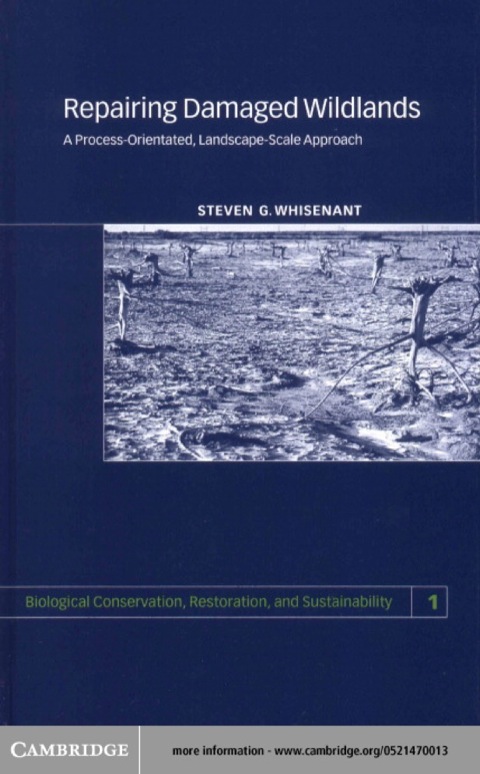Description
Efnisyfirlit
- Half-title
- Series-title
- Title
- Copyright
- Contents
- Preface
- Acknowledgments
- 1 Wildland degradation and repair
- Introduction
- Degradation
- Setting realistic objectives
- What do we call what we want to accomplish?
- Repairing damaged wildlands
- Philosophical approaches
- AGRONOMIC APPROACH
- ECOLOGICAL APPROACH
- Recommended approach
- PROCESS-ORIENTED STRATEGIES
- INITIATE AND DIRECT AUTOGENIC PROCESS
- CONSIDER LANDSCAPE INTERACTIONS
- 2 Assessing damage to primary processes
- Introduction
- What is proper versus damaged functioning?
- Conservation of resources
- LANDFORM AND GEOMORPHIC PROCESSES
- BIOTIC CONTROLS
- Proper hydrologic functioning
- INFILTRATION AND RUNOFF
- EVAPORATION, TRANSPIRATION, AND SALINIZATION
- Erosion
- WATER (FLUVIVAL) EROSION
- WIND (EOLIAN) EROSION
- Assessing wildland processes
- Soil stability and hydrologic functioning
- SOIL SURFACE CONDITIONS
- SURFACE ROUGHNESS
- THRESHOLD WIND EROSION VELOCITY
- RAIN USE EFFICIENCY
- PROPER FUNCTIONING CONDITION OF RIPARIAN WETLANDS
- Nutrient cycling
- NUTRIENT AVAILABILTY IN ECOSYSTEMS
- COMMUNITY RESPONSE TO FERTILIZATION
- NUTRIENTS AND SUCCESSION
- Visual assessments of nutrient cycling
- 3 Repairing damaged primary processes
- Introduction
- Improving soil surface conditions
- Increase surface soil roughness
- CONTROLLING WIND EROSION WITH ROUGHER SOIL SURFACES
- Add aboveground obstructions
- TYPES OF ABOVEGROUND OBSTRUCTIONS
- PLANTS AS OBSTACLES TO FLUVIVAL FLOWS
- PLANTS AS OBSTACLES TO EOLIAN FLOWS
- PREPARATORY CROPS
- SHELTERBELTS
- Use soil conditioners
- Initiate microbiotic crust development
- Increasing resource retention
- Match vegetation with the nutrient regime
- NITROGEN
- SOIL PH
- NUTRIENT CYCLING
- Repair or replace biotic processes in the soil
- Add organic materials
- Other hydrologic problems
- Dryland salinization
- Gully erosion
- Compacted soils
- 4 Directing vegetation change
- Introduction
- Understanding vegetation change
- Process and context
- Uncertainty, rare and infrequent events
- Temporal and spatial variability
- Multiple mechanisms of change
- Multiple stable-states and transition thresholds
- TRANSITIONS CONTROLLED BY ABIOTIC LIMITATIONS
- TRANSITIONS CONTROLLED BY BIOTIC INTERACTIONS
- Setting goals
- Directing change
- Differential species performance
- PLANT-TO-PLANT INTERACTIONS
- RESOURCE AVAILABILITY
- HERBIVORY
- Differential site availability
- SAFE SITES
- AUTOGENIC DEVELOPMENT
- Differential species availability
- DISPERSAL
- SEED PREDATORS
- 5 Selecting plant materials
- Introduction
- Species and species mixtures
- Native species
- SEED SOURCE
- USING NONNATIVE SPECIES
- Species diversity
- GENETIC DIVERSITY
- Functional diversity
- ECOLOGICAL STRATEGIES
- REGENERATION STRATEGIES
- POLLINATION REQUIREMENTS
- SITE STABILIZATION AND PRIMARY PROCESS REPAIR
- FUNCTIONAL REDUNDANCY
- Assembly rules
- Self-design
- Which plant part should be planted?
- Seed
- SEED QUALITY
- COLLECTING SEED
- STRONG SEED
- HAY MULCH AS SOURCE OF SEED
- FLUPPY GRASS SEED OR BARE CARYOPSIS
- SEED FROM TOPSOIL ADDITIONS
- Whole plants
- WILDINGS
- RARE-ROOT STOCK
- CONTAINER-GROWN STOCK
- SOD
- Plant parts
- 6 Site preparation and seedbed management
- Introduction
- Unassisted natural recovery
- Assisted natural recovery
- Artificially induced recovery
- Why do seedings fail?
- GERMINATION AND EMERGENCE
- ESTABLISHMENT
- Seedbed preparation
- MECHANICAL AND MANUAL METHODS
- CHEMICAL METHODS
- BURNING METHODS
- BIOLOGICAL METHODS
- Special seedbed considerations
- Water-limiting environments
- WATER HARVESTING
- SNOWFENCES
- Salinized soils
- Active sand dunes
- Mulches
- 7 Planting
- Introduction
- Direct seeding
- Seed preparation
- BREAKING SEED DORMANCY
- INOCULATION
- Planting time
- Seeding rate
- SEEDING RATES AND COMPETITIVE INTERFERENCE
- PLANTING VERY LOW SEEDING RATES
- Seeding depth
- Drill seeding
- INTERSEEDING
- Broadcast seeding
- SEEDBED REQUIREMENTS
- AERIAL SEEDING
- HAY MULCH SEEDING
- CULTIPACKER-TYPE SEEDERS
- HYDROSEEDING
- Transplanting
- Planting densities for trees and shrubs
- Wildings
- Sod
- Bare-root stock
- Container-grown stock
- Cuttings
- WOODY CUTTINGS
- SPRIGS
- Maintenance of planted landscapes
- Prairies
- Forests and woodlands
- Protecting shrub and tree seedlings
- CHEMICAL REPELLENTS
- PROTECTIVE TUBES
- 8 Planning repair programs for wildland landscapes
- Introduction
- Understanding landscapes
- Landscape structure
- Landscape function
- Guidelines for designing landscapes
- Treat causes rather than symptoms of degradation
- Emphasize process repair over structural replacement
- Design repair actions at the proper scale
- Design landscapes to increase retention of limiting resources
- Design spatial variation into landscapes
- Design landscapes to maintain the integrity of primary processes
- Design linkages into landscapes
- Design propagule donor patches into landscapes
- Design landscapes to encourage animal dispersal of desired seed
- Design landscapes to encourage wind dispersal of desired seed
- Design landscapes to encourage positive animal interactions
- Design landscapes to improve the microenvironment at different scales
- A decision-making framework
- Context analysis
- SOCIOECONOMIC CONTEXT
- ECOLOGICAL CONTEXT
- Risk and uncertainty
- ASSESSING RISK AND UNCERTAINTY
- CLIMATIC UNCERTAINTY
- TECHNICAL UNCERTAINTY
- SOCIOECONOMIC UNCERTAINTIES
- PLANNING FOR RISK AND UNCERTAINTY
- Management intervention
- Monitoring and evaluation
- REFERENCE SITES
- MEASURING PROGRESS
- Literature cited
- Index






Reviews
There are no reviews yet.